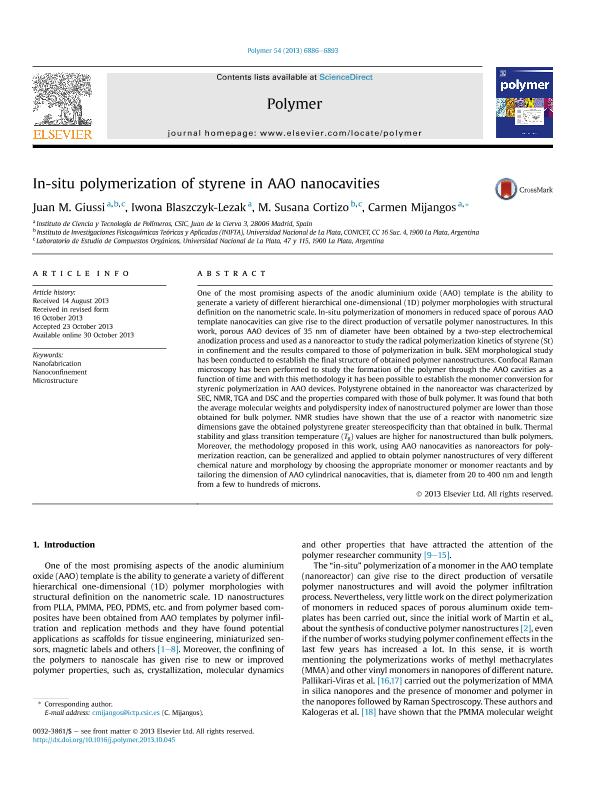Mostrar el registro sencillo del ítem
dc.contributor.author
Giussi, Juan Martín

dc.contributor.author
Blaszczyk Lezak, Iwona
dc.contributor.author
Cortizo, Maria Susana

dc.contributor.author
Mijangos, Carmen
dc.date.available
2016-04-21T17:41:58Z
dc.date.issued
2013-10
dc.identifier.citation
Giussi, Juan Martín; Blaszczyk Lezak, Iwona; Cortizo, Maria Susana; Mijangos, Carmen ; In-situ polymerization of styrene in AAO nanocavities; Elsevier; Polymer; 54; 26; 10-2013; 6886-6893
dc.identifier.issn
0032-3861
dc.identifier.uri
http://hdl.handle.net/11336/5315
dc.description.abstract
One of the most promising aspects of the alumina oxide (AAO) template is the ability to generate a variety of different hierarchical one-dimensional (1D) polymer morphologies with structural definition on the nanometric scale. In-situ polymerization of monomers in reduced spaces of porous aluminum oxide (AAO) nanocavities can give rise to the direct production of versatile polymer nanostructures. In this work, porous anodic aluminum oxide (AAO) devices of 35 nm of diameter have been obtained by a two-step electrochemical anodization process and used as a nanoreactor to study the radical polymerization kinetics of styrene (St) in confinement and the results compared to those of polymerization in bulk. SEM morphological study has been conducted to establish the final structure of obtained polymer nanostructures. Confocal Raman microscopy has been performed to study the formation of the polymer through the AAO cavities as a function of time and with this methodology it has been possible to establish the monomer conversion for styrenic polymerization in AAO devices. Polystyrene obtained in the nanoreactor was characterized by SEC, NMR, TGA and DSC and the properties compared with those of bulk polymer. It was found that both the average molecular weights and polydispersity index of nanostructured polymer are lower than those obtained for bulk polymer. NMR studies have shown that the use of a reactor with nanometric size dimensions gave the obtained polystyrene greater stereospecificity than that obtained in bulk. Thermal stability and Tg values are higher for nanostructured than bulk polymers. Moreover, the methodology proposed in this work, using AAO nanocavities as nanoreactors for polymerization reaction, can be generalized and applied to obtain polymer nanostructures of very different chemical nature and morphology by choosing the appropriate monomer or monomer reactants and by tailoring the dimension of AAO cylindrical nanocavities, that is, diameter from 20 to 400 nm and length from a few to hundreds of microns.
dc.format
application/pdf
dc.language.iso
eng
dc.publisher
Elsevier

dc.rights
info:eu-repo/semantics/openAccess
dc.rights.uri
https://creativecommons.org/licenses/by-nc-nd/2.5/ar/
dc.subject
Nanofabrication
dc.subject
Nanoconfinement
dc.subject
Microstructure
dc.subject.classification
Físico-Química, Ciencia de los Polímeros, Electroquímica

dc.subject.classification
Ciencias Químicas

dc.subject.classification
CIENCIAS NATURALES Y EXACTAS

dc.title
In-situ polymerization of styrene in AAO nanocavities
dc.type
info:eu-repo/semantics/article
dc.type
info:ar-repo/semantics/artículo
dc.type
info:eu-repo/semantics/publishedVersion
dc.date.updated
2016-05-06 15:52:43.262787-03
dc.journal.volume
54
dc.journal.number
26
dc.journal.pagination
6886-6893
dc.journal.pais
Países Bajos

dc.journal.ciudad
Amsterdam
dc.description.fil
Fil: Giussi, Juan Martín. Consejo Nacional de Investigaciones Científicas y Técnicas. Centro Científico Tecnológico la Plata. Instituto de Investigaciones Fisicoquímicas Teóricas y Aplicadas; Argentina. Instituto en Ciencia y Tecnologia de Polimeros; España. Universidad Nacional de la Plata. Facultad de Ciencias Exactas. Departamento de Quimica. Laboratorio de Estudio de Compuestos Organicos; Argentina
dc.description.fil
Fil: Blaszczyk Lezak, Iwona. Instituto en Ciencia y Tecnologia de Polimeros; España
dc.description.fil
Fil: Cortizo, Maria Susana. Consejo Nacional de Investigaciones Científicas y Técnicas. Centro Científico Tecnológico la Plata. Instituto de Investigaciones Fisicoquímicas Teóricas y Aplicadas; Argentina. Universidad Nacional de la Plata. Facultad de Ciencias Exactas. Departamento de Quimica. Laboratorio de Estudio de Compuestos Organicos; Argentina
dc.description.fil
Fil: Mijangos, Carmen . Instituto en Ciencia y Tecnologia de Polimeros; España
dc.journal.title
Polymer

dc.relation.alternativeid
info:eu-repo/semantics/altIdentifier/url/http://www.sciencedirect.com/science/article/pii/S0032386113010033
dc.relation.alternativeid
info:eu-repo/semantics/altIdentifier/doi/10.1016/j.polymer.2013.10.045
dc.relation.alternativeid
info:eu-repo/semantics/altIdentifier/doi/http://dx.doi.org/10.1016/j.polymer.2013.10.045
Archivos asociados
